Urban areas often bustle with commercial activities, leaving little room for green spaces. However, an innovative solution is emerging in cities worldwide: pop-up parks. These temporary green spaces transform underutilized urban areas into vibrant, community-focused environments. In this blog, we will explore the definition and purpose of pop-up parks, their benefits for urban commercial regions, real-world examples in British Columbia, how they are implemented, the potential challenges, and future trends.
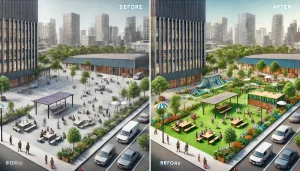
Definition and Purpose of Pop-Up Parks
Pop-up parks are temporary green spaces created in urban environments, typically using vacant lots, parking spaces, or underutilized areas. These parks are designed to be temporary, lasting from a few days to several months, depending on the project’s scope and community needs. The primary purpose of pop-up parks is to introduce greenery into concrete-dominated urban areas, providing residents and visitors with a place to relax, socialize, and engage in recreational activities.
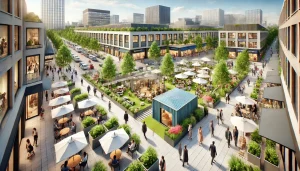
Benefits for Urban Commercial Areas
Pop-up parks offer numerous benefits for urban commercial areas:
- Enhanced Aesthetic Appeal: Pop-up parks add visual interest to otherwise drab urban landscapes, making commercial areas more attractive to visitors and potential customers.
- Increased Foot Traffic: Green spaces attract people, increasing foot traffic in commercial zones benefiting local businesses.
- Community Engagement: These parks provide a space for community events, fostering residents’ sense of belonging and social interaction.
- Environmental Impact: Pop-up parks can improve air quality, reduce urban heat islands, and promote biodiversity by introducing plants and trees into the cityscape.
- Economic Boost: Pop-up parks can stimulate economic activity and support local businesses by attracting more visitors.
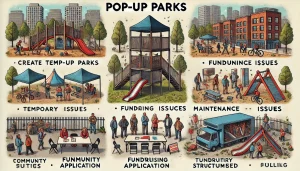
Real-World Examples in British Columbia
British Columbia has embraced the concept of pop-up parks with several successful implementations:
- Vancouver’s Parklets Program: Vancouver has transformed numerous parking spaces into small, vibrant parklets. Adorned with seating, greenery, and art installations, these spaces have revitalized areas such as Robson Street and Commercial Drive.
- Victoria’s Temporary Park on Pandora Avenue: Victoria introduced a temporary park, complete with seating areas, plants, and interactive installations. This initiative aimed to provide a green respite in the city’s heart while encouraging community interaction.
- Surrey’s Pop-Up Parks: Surrey has experimented with pop-up parks in various neighbourhoods to promote community activities and local markets. These parks have been well-received, highlighting the demand for more green spaces in urban areas.
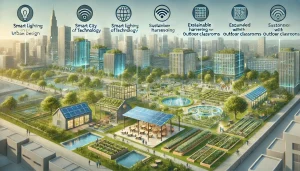
Implementation of Pop-Up Parks
Implementing a pop-up park involves several key steps:
- Identifying Suitable Locations: Urban planners and community leaders identify underutilized areas that could benefit from temporary green spaces.
- Design and Planning: Designing a pop-up park involves collaborating with landscape architects, urban planners, and the community to create a space that meets local needs.
- Securing Funding: Funding can come from various sources, including municipal budgets, grants, sponsorships, and community fundraising.
- Construction and Installation: Temporary structures, plants, seating, and other amenities are installed, often using modular and sustainable materials.
- Community Engagement: Engaging the community through events, workshops, and volunteer opportunities helps ensure the park’s success and fosters a sense of ownership among residents.
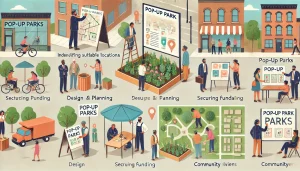
Potential Challenges
While pop-up parks offer numerous benefits, they also present challenges:
- Temporary Nature: As temporary installations, pop-up parks may only provide short-term solutions for urban green space needs.
- Funding and Resources: Securing adequate resources can be challenging, particularly for smaller communities or projects.
- Maintenance: Ensuring the park remains clean, safe, and well-maintained throughout its lifespan requires ongoing effort and coordination.
- Community Buy-In: Gaining community support and participation is crucial, and some residents may need more support for changes in their urban environment.
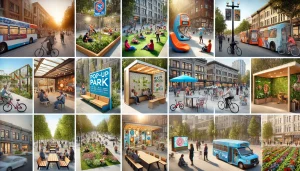
Future Trends
The future of pop-up parks looks promising, with several trends emerging:
- Integration with Smart City Technology: Incorporating technology such as Wi-Fi hotspots, smart lighting, and interactive installations can enhance the appeal and functionality of pop-up parks.
- Sustainable Design: Using sustainable materials and practices like rainwater harvesting and solar power can make pop-up parks more environmentally friendly.
- Expanded Scope: Beyond traditional green spaces, future pop-up parks may include features like urban farms, outdoor classrooms, and fitness areas.
- Permanent Transformations: Successful pop-up parks could pave the way for permanent green spaces, demonstrating the value of urban greenery to city planners and developers.
In conclusion, pop-up parks are an innovative solution to the challenge of creating green spaces in urban commercial areas. These temporary parks offer significant benefits by enhancing aesthetics, boosting foot traffic, and fostering community engagement. With successful examples in British Columbia and promising future trends, pop-up parks are poised to become a staple of urban planning, providing much-needed green spaces in cities worldwide.